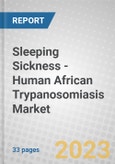The market for sleeping disorders will be thoroughly covered in the current report. The epidemiology, geographical markets, and market trends for sleeping sickness are examined in this paper. This study will highlight the present sleeping sickness market and provide a thorough analysis of the market's competitive landscape.
Report Includes
- An overview and up-to-date analysis of the global sleeping sickness market
- Analyses of the global market trends, with historical market revenue data (sales figures) from 2020 to 2022, estimates for 2023, and projections of compound annual growth rates (CAGRs) through 2028
- Estimate of the actual market size and revenue forecast for the global sleeping sickness market in USD millions, and corresponding market share analysis based on diagnosis type, treatment modality, and geographic region
- In-depth information (facts and figures) pertaining to the market growth drivers, opportunities and challenges, upcoming technologies, future prospects, and regulatory scenarios; and the impacts of COVID-19 and the Russia-Ukraine war on the market
- Discussion of the importance of ESG in sleeping sickness market, including consumer attitudes, impact of ESG factors on company performance, and the ESG practices followed
- Identification of the major stakeholders, and analysis of their company competitive landscape based on news/developments, company financials, competitive strategies, and operational integration
- Company profiles of major players within the industry
Table of Contents
Executive Summary
Human African trypanosomiasis (HAT) is still a problem in many sub-Saharan African nations, especially in areas with poor infrastructure and resources for treatment. Although the disease has been somewhat controlled, work still needs to be done to completely eradicate it, and vigilante measures must be taken to avoid a comeback. The funding from governments, NGOs and pharmaceutical firms for HAT research and development is increasing. Improved diagnostic equipment, therapies, and preventative measures are likely to be the outcome of this.
The tsetse fly spreads this disease in humans by biting and feeding on blood. The Diptera order contains the Glossina vector. Because Glossina are viviparous, both the male and the female can transmit disease. The transmission of parasites is carried out by numerous subgenus flies, including G. palpalis palpalis, G. p. gambiensis, and G. morsitans, which transmits T. b. rhodesiense. For these flies to live, specific temperatures and relative humidity ranges of 50% to 80% are required. The Glossina, however, is categorized as a 'bad vector' since the female only produces 10 larvae in her lifetime and because it loses parasites at every blood feeding.
The symptoms of T. b. gambiense and T. b. rhodesiense are frequently the same, although their frequency, severity, and kinetic appearance vary. HAT clinically develops in two stages. In fact, T. b. rhodesiense can result in patient mortality within six months, but T. b. gambiense patients can survive for more than 10 years.
Companies Mentioned
- Bayer AG
- Sanofi








